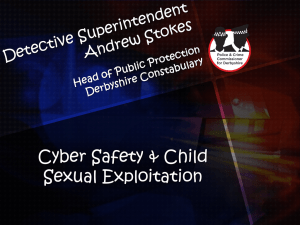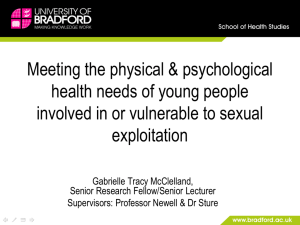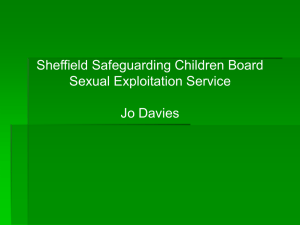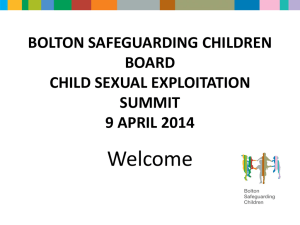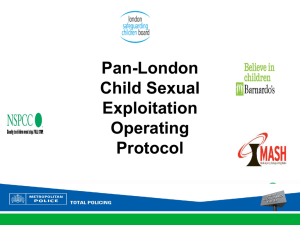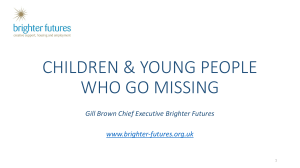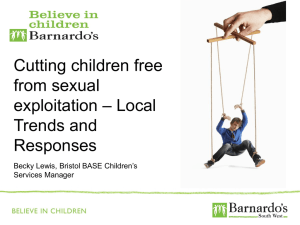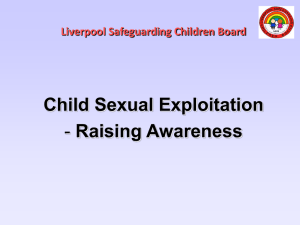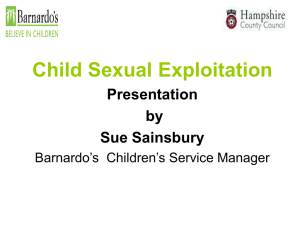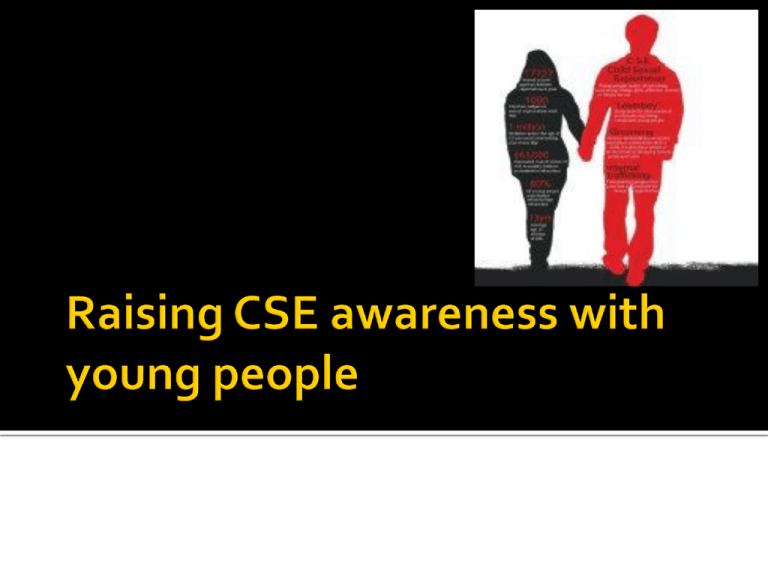
To ensure all participant have improved
confidence in the knowledge and delivery of
the sensitive issues surrounding CSE
Resources
Raise awareness across the board
Look for any possible indicators of CSE
Challenge thinking
Start conversations and discussion about
relationships
Support where appropriate
Keep informed and up to date with
procedures and information
Online Pupil data for your setting
Sexual exploitation of children and young people
under 18 involves exploitative situations, contexts and
relationships where young people (or a third person or
persons) receive ‘something’
(e.g. food, accommodation, drugs, alcohol, cigarettes,
affection, gifts, money) as a result of them
performing, and/or another or others performing on
them, sexual activities.
At least 1,400 children were subjected to
appalling sexual exploitation in Rotherham
between 1997 and 2013, a report has found.
Children as young as 11 were raped by
multiple perpetrators, abducted, trafficked to
other cities in England, beaten and
intimidated, it said.
The report, commissioned by Rotherham
Borough Council, revealed there had been
three previous inquiries.
Schools
8.9
Schools were a key element in the frontline of
protecting children from sexual exploitation.
Perpetrators targeted schools and there was
evidence in the files (historically and up to the
time of the Inquiry) that schools were proactive
in alerting Risky Business, children’s social care
and the Police to signs and evidence of
exploitation.
8.10
From its inception, Risky Business provided
training programmes to schools with a view to
raising young people's awareness of CSE and its
dangers and giving them a chance to voice
concerns about their own situation. Workshops
in schools covered grooming and the internet.
News today!
“Community leaders will sit down later
today to discuss the findings of a review
into child sexual exploitation in the city.
Stoke-on-Trent City Council
commissioned the report in May after it
was revealed that 27 children were
sexually exploited in the city last year,
78 were at risk.” Stoke Sentinel
1000
children subjected to sexual exploitation each day*
* The Child Sexual Exploitation – Gangs and Group Enquiry (CSEGG)
13 yrs
average age of Child Sexual Exploitation*
*Barnardos Children's Charity
80%
of young people want better relationship education at
secondary school*
*Brook for Young People
Online safety: How much do they know about Grooming & how to
keep safe? (Secondary phase n = 8,950)
Year 8 & 10, Knowledge about keeping safe online from
Grooming
60%
57%
56%
56%
50%
40%
30%
26%
25%
26%
20%
17%
20%
19%
10%
0%
Nothing/Not much
Some
Boys
Girls
Quite a lot/lots
Total
Just over half feel they have a lot of knowledge about how to keep safe from grooming online.
Little difference between genders.
© Foster & Brown Research 2014
Online safety: How much do they know about Grooming & how to
keep safe? Should young people my age be taught more?
Year 8 & 10, do young people their age need to be taught
more about keeping safe online from Grooming
70%
59%
60%
50%
54%
49%
40%
30%
20%
10%
0%
Yes (taught more)
Boys
Girls
Total
Just over half feel they should be taught more about this. Girls more so than boys.
© Foster & Brown Research 2014
Grooming: Have you ever met a Stanger in the real world that you first
got to know online (Secondary phase n = 8,985)
Year 8 & 10, Met up with a stranger they first got to know
online
100%
90%
88%
87%
88%
80%
70%
60%
50%
40%
34%
28%
30%
24%
20%
13%
12%
12%
10%
0%
No
Yes
Went on own to meet them
12.4% say they have met a stranger in realBoys
life that
they Total
first got to know online, nearly a third
Girls
(who met up with a stranger) went on their own to meet them. Again little gender difference.
© Foster & Brown Research 2014
Grooming: Have you ever met a Stanger in the real world that you first
got to know online (Secondary phase n = 1,088)
Year 8 & 10, Who did they take to meet up with the stranger?
70%
65%
60%
60%
54%
50%
40%
34%
28%
30%
24%
20%
10%
8% 7% 7%
1% 2% 2%
3% 3% 3%
Another adult
Sibling
0%
Went on own to meet With parent/carer
them
Boys
Girls
Friend
Total
12.4% say they have met a stranger in real life that they first got to know online, nearly a third
(who met up with a stranger) went on their own to meet them. 60% took a friend.
© Foster & Brown Research 2014
Grooming: Met a Stanger in the real world that you first got to know
online (Secondary phase n = 78)
Year 8 & 10, How old was the stranger?
70%
63%
60%
50%
40%
46%
36%
30%
24%
19%
20%
18% 19% 18%
16%
11%
11%
10%
7%
6%
4%
4%
Adult
Would rather not say
0%
Same age
Younger
Boys (n=45)
Older
Girls (n=27)
Total (n=72)
12.4% say they have met a stranger in real life that they first got to know online, nearly a third
(who met up with a stranger) went on their own to meet them. 60% took a friend.
© Foster & Brown Research 2014
It can happen to boys and girls
It can happen in rural and urban areas
It can happen face to face
It can happen online
It is a form of child abuse and should be
treated as a child protection issue
Going missing for periods of time or regularly returning home late
Disengagement from education
Appearing with unexplained gifts or new possessions
Peers and friends
Sexual health issues
Changes in temperament/depression
Drugs and alcohol misuse
Displaying inappropriate sexualised behaviours
Involvement in exploitative relationships or association with risky adults
(Source: Barnardo’s ‘Puppet on a string’, 2011)
Signs and indicators Sch/Col exercise – Pg 19 Love or Lies
Signs of child sexual exploitation 'being missed'
Teachers, social workers and the police are missing the warning signs of children
being targeted for sexual exploitation, a charity has said.
Barnardo's said children who were being groomed often appeared with
unexplained gifts or started engaging in risky behaviour.
They also tended to start skipping school or becoming disruptive, it said.
People working with children needed to be made aware of the "tell-tale signs", it
added.
These also include secretive use of mobile phones and the internet.
Some children might use drugs or be encouraged to do so by those attempting
to control them, it added.
BBC News July 2010
Allocate to appropriate team to investigate
The CSE Team
• Access and referral forms and take action with social care
• Investigate organised CSE where groups and gangs of
individuals are involved in the sexual exploitation of
children or localised (or on-street) grooming and internal
trafficking
• Support educational establishments in preventative work
• Advice where appropriate
Request for service/referral
Information gathering – single agency
Is child at risk of CSE?
Yes
Information
No
Advice given
Can be located at www.gscb.org.uk/article/113294/Gloucestershire-procedures-andprotocols
Tool kit
Where to find it
http://www.gscb.org.uk/article/113294/Glouces
tershire-procedures-and-protocols
Child Sexual Exploitation police contacts:
Ds Nigel Hatten
Dc Katie McGurk, Dc Karen Swinyard,
Pc Nicki Dannatt, Pc Jenny Kadodia,
Pc Dawn Collings
tel - 01242 276846
All Referrals to go to the Central Referral Unit
01242 247999
“Nobody warned me about sexual exploitation,
nobody warned me that there are lads who drive
round in their posh cars and loud music, and try
to groom girls. I didn’t warn my daughter. I want
other parents to be aware.” (Parent, quoted)
• Carlie was raped, physically and sexually abused over a
four year period.
• She was introduced to adult perpetrators through other
young women.
• She is 15 years old .
• She was groomed through alcohol, drugs and gifts.
• One perpetrator told her that he was a theatre producer
and promised her an acting role.
• The perpetrators who were identified were previously
known to the Police.
• Carlie associated with other young people who were
involved in sexual exploitation.
CSE experiences can cause young people long
term physical, mental and emotional damage
and can significantly impact on their ability to
make and sustain successful, stable
relationships in the future.
Substance misuse
Unintended pregnancies
STI’s
Homelessness
Anxiety and depression
Crime
Victims of domestic violence
This high lights the importance of prevention
and early intervention to protect young people.
Gloucestershire Healthy Living and
Learning(GHLL)
CSE Police Unit
Safe Guarding (GSCB)
School Nurses
Youth Mental Health First Aid – (GHLL)
Childline
NSPCC
Barnardos
GDVSAP
Youth Support Service
My Dangerous Loverboy – UKHT
Barnardos
NSPCC
Sex Education Forum
CEOP (Think u Know and Exploited)
Friend or foe? (Safe Guarding Children –Sheffield)
NWG (National working group for CSE)
UK Safer Internet Centre
Gloucestershire Exploitation Lesson
Chelsea’s Choice
Back-ground research (Girl A – Anonymous)
Holding On To You (Radio 4 drama)
Where are you delivering this work?
Size of group?
Mixed gender groups?
Advantages/disadvantages
Age?
Should it be delivered to young people who have
been part of work looking at healthy
relationships and sexual health?
Children who have been identified at risk?
PSHE/Pastoral teams – discuss, share and
cascade
Further training (GSCB)
Would you know how to support a young
person – referring to specialist?
Make sure you are aware of safe guarding
procedure in your establishment– disclosure
Referral form
GSCB – Gloucestershire Safe Guarding
Children's Board
http://www.gscb.org.uk/article/111301/Home-Page
A continuous, progressive curriculum relevant
to needs of students
This will involve some introductory work before
the introduction of the CSE topic
Healthy relationships
Staying safe
Sexual health
What preparation do you need to do before
covering this sensitive topic?
Teachers need to be prepared before it is delivered
to young people so that they can support young
people effectively.
Be clear about procedures at your establishment if
a young person discloses.
Ensure other staff members are aware of topic
being delivered.
GHLL/CSE Police Exploitation Lesson –
Year 8 students (12/13yrs) prior to having
Chelsea’s Choice Play
(Good starting point for topic)
What do these
images have in
common?
Exploitation
Unfair treatment of someone, or the use of a
situation in a way that is wrong, in order to
get some benefit for yourself
The process of making use of something so
that you gain as much as possible from it
Manipulation, forced into taking part in
something
Card sort – how risky is it?
Make young people aware of ‘risk’ and the
need to assess situations and level of risk.
http://www.youtube.com/watch?v=Kxhgv61a0OI
Produced by UKHTC (UK Human Trafficking
Centre) in 2009 and reprinted in 2011 in
association with SOCA (Serious Organised
Crime Agency)
www.mydangerousloverboy.com
Know your audience – suggest yr9 (14yrs) and
above
Based on information from specialist
services, frontline practitioners and young
people’s stories and experiences
In small groups discuss:
o What do you know about Jade?
o What do you know about Raz?
o Can you identify any risks so far?
o How could Jade minimise these risks?
What has happened to Jade?
Has Raz been grooming Jade? If so, how was
he doing it?
Did this feel like a healthy relationship at
first?
When did it stop feeling like that?
How could Jade have kept herself safe?
What if…
No, because…
A good night out/A safe night out board
Pressure points and strategies
What has happened to Jade now?
Is Jade a consenting party?
Could she have done anything to get away or
keep herself safe?
What can Jade do now?
Something’s wrong
Helping Friends
Asking questions
Helping hands
Things I’m not happy about
Phone a friend/Draft a text message
Self assessments
Consider creative methods of delivery – such as
graffiti, role play, art, questions in a hat, board
games, thoughts in a box…
Have a credible delivery style that avoids
judgements, uses plain language and concepts
Be responsive to their reactions
Distancing techniques to give them time to
discuss in small groups
Get them to complete learning journals with
action points
Get them to do their own self or risk assessment
Drama/dance
Deal with any questions or concerns
Give them permission/actively encourage
them to talk about the issues
Tell them where to go if they want help
Get their thought s on the sessions
Get involved in designing future sessions
End on a positive note –
e.g. Disassociation games similar to ice breaker
activities
Time and privacy for any young person
affected by the issues
List of local and national resources
Clear understanding that if a young person
discloses that they are being groomed or
sexually exploited, your setting must make
referrals to the police and social care without
delay – you therefore need to be familiar with
local policies
“Don’t let guys groom you. If they give you lots
of stuff, or buy you drinks, don’t think that
means they love you. Or if they take you to a
hotel for the night, and they’re paying for it, it’s
because they want something for it. I felt so
lonely, I had no one to talk to, and that’s how I
ended up with bad people, and bad things
happened to me.”
(Young victim, quoted by Children’s Society’)
Raising awareness in your own establishment
(All staff and parent/carers)
Make people aware of screening tool
http://www.youtube.com/watch?v=bBhGgNQY8CY

